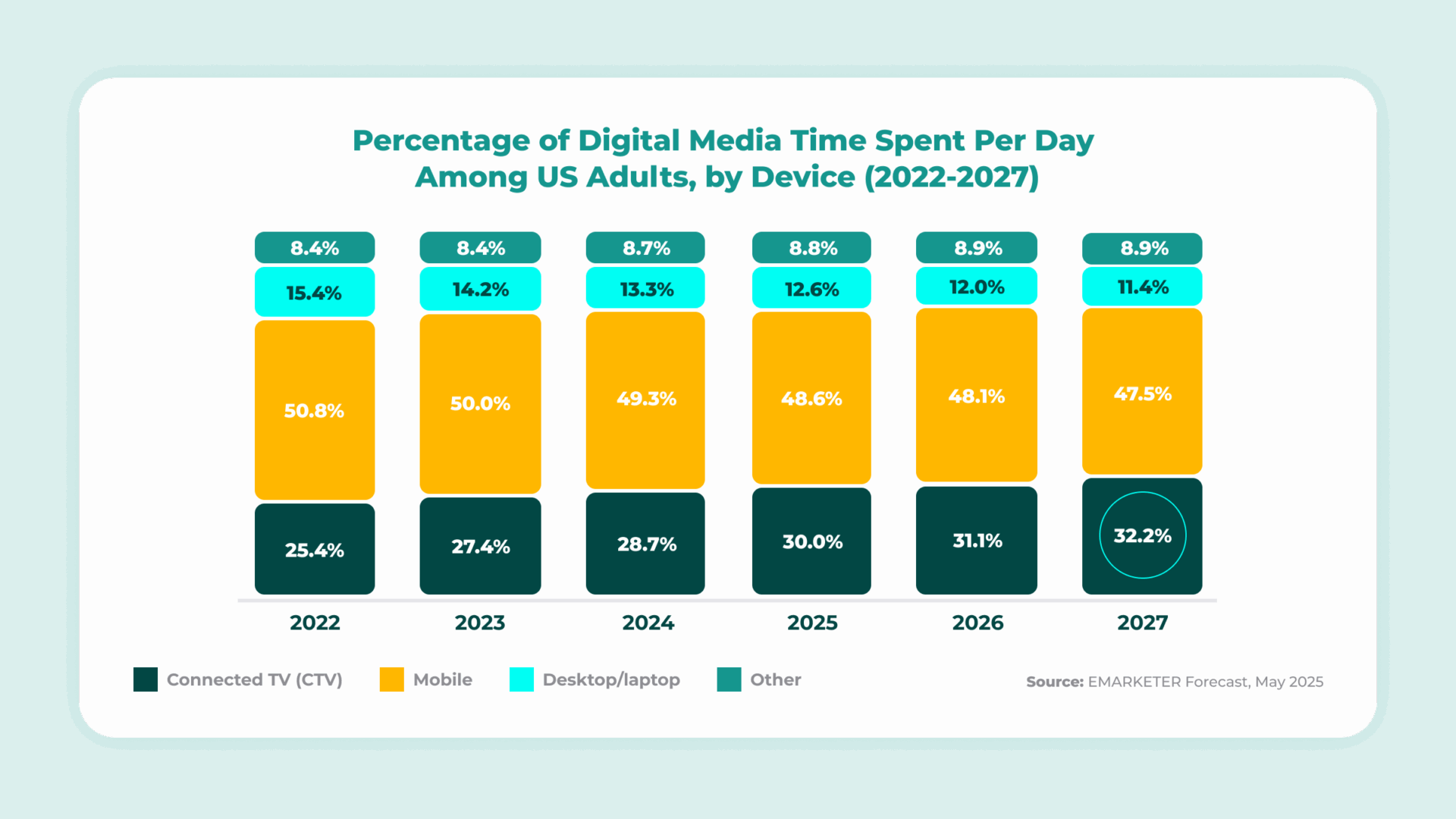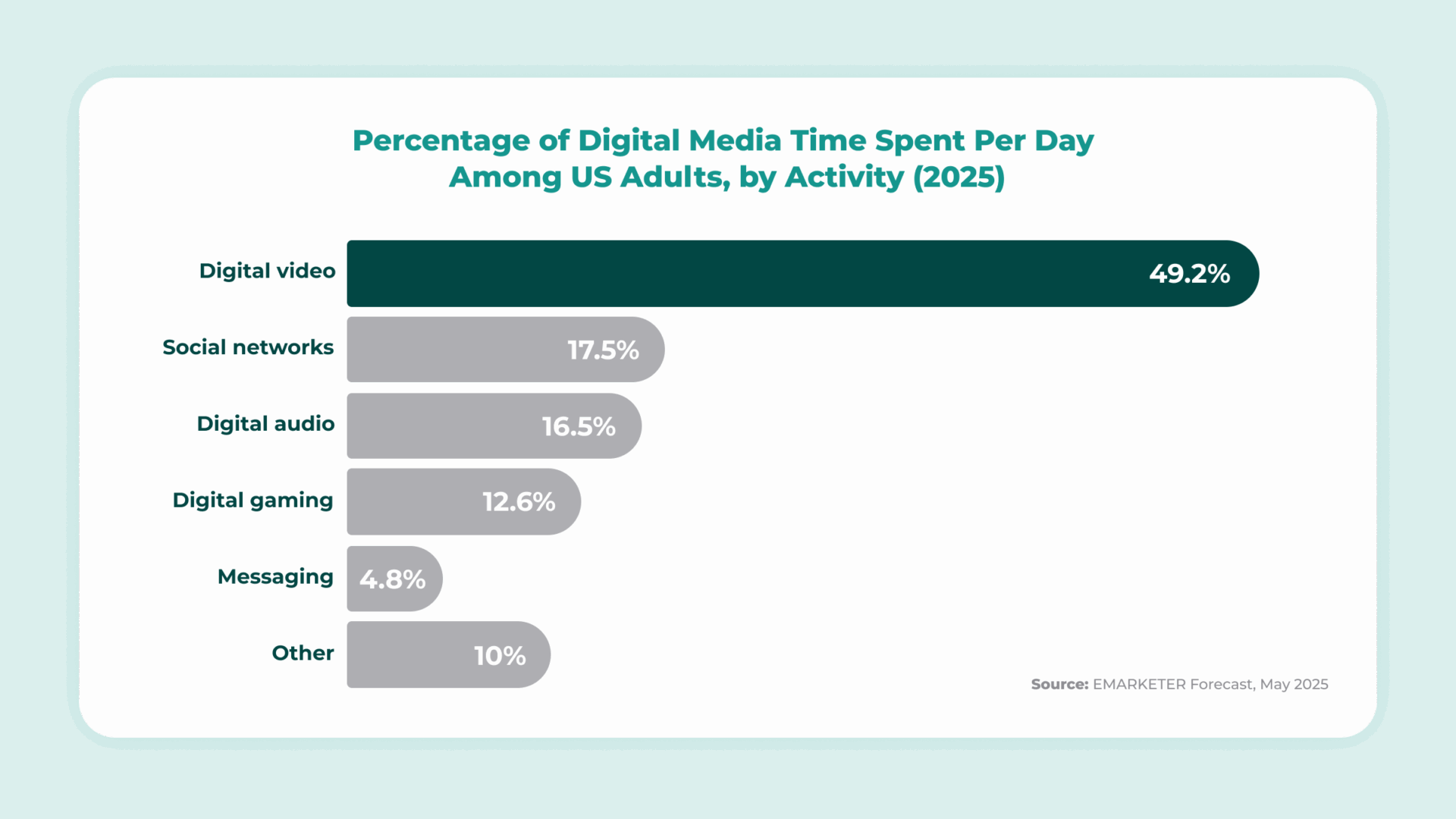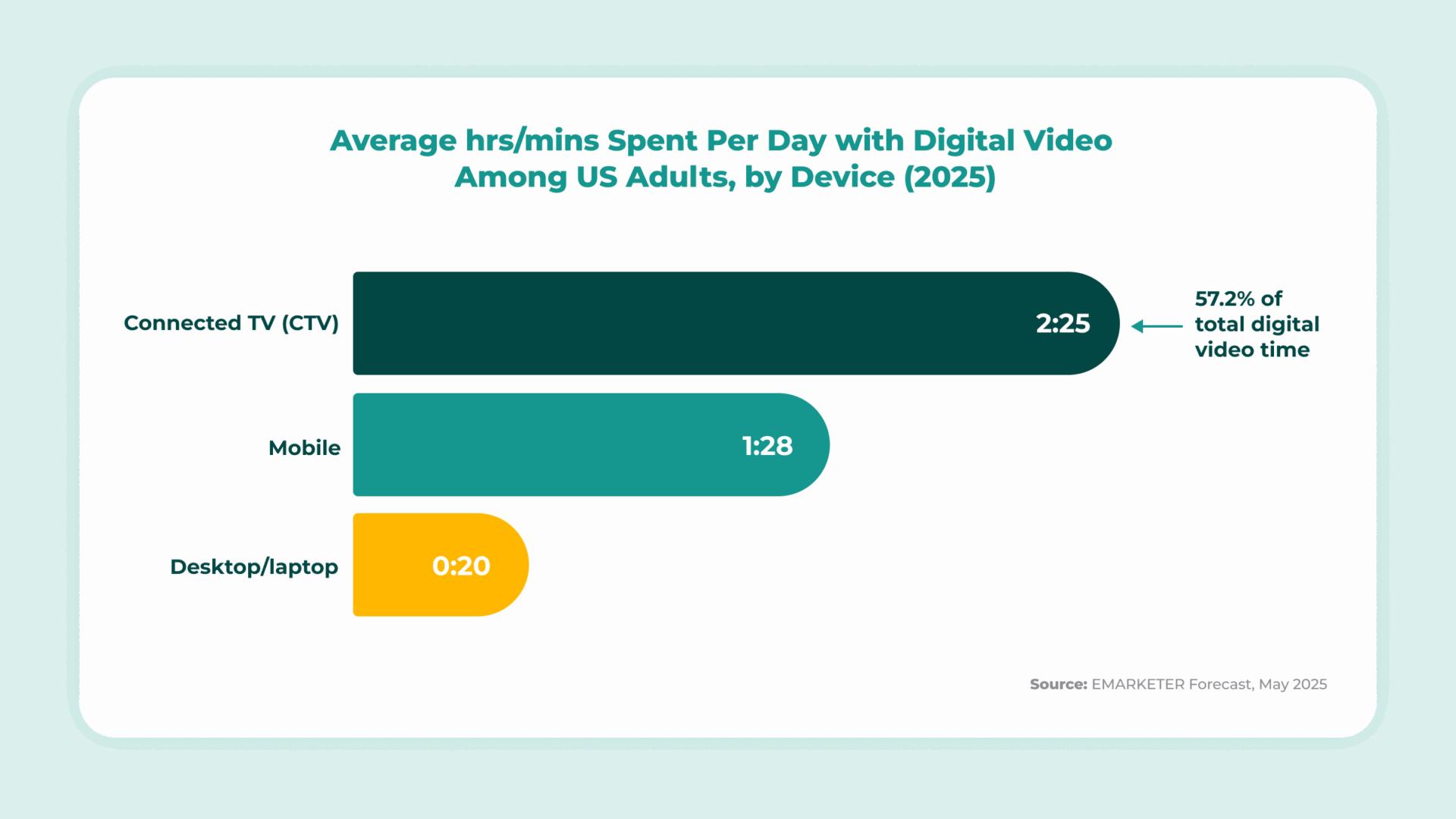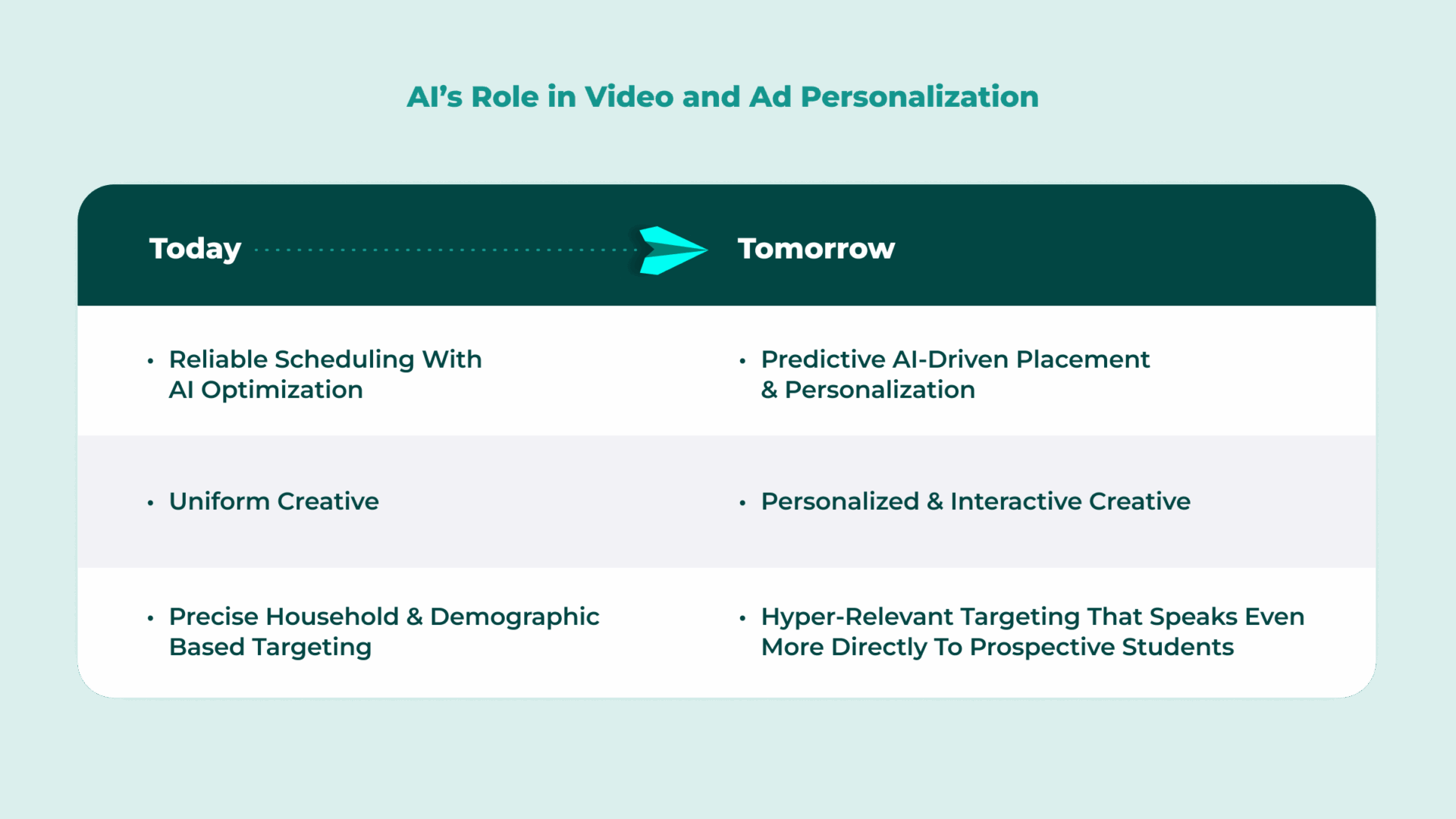CTV Is Higher Ed’s Biggest Opportunity in 2025
CTV is climbing fast while mobile stalls.
Are you ready?

Digital habits are shifting, and higher ed can’t afford to ignore it. In fact, fresh data from EMARKETER’s May 2025 report shows that CTV will capture 30% of all digital media time in 2025, while mobile use is actually starting to plateau. You can read the full study here: Time Spent With Connected Devices 2025. Translation? Students and parents aren’t just scrolling anymore. They’re streaming. And that’s where your campaigns need to show up.
The rise of CTV isn’t just another media shift. It’s a complete reset of where attention lives. For enrollment marketers, this means the strategies that worked five years ago won’t work five years from now. Students aren’t waiting around for static posts in their feeds, and parents aren’t flipping through glossy viewbooks the way they used to. They’re streaming shows, live sports, and binge-worthy series. In those moments, your message can’t be background noise. It needs to land on the biggest screen in the room, when audiences are most engaged.
1. Mobile Is Plateauing. CTV Is Rising.
For the past decade, higher ed marketing strategies leaned heavily on mobile. Social ads, mobile search, endless retargeting—all optimized for the small screen. And for good reason: mobile once captured nearly half of all digital time.
But the tide is turning. EMARKETER shows that mobile’s share of digital time dipped from 49.3% in 2024 to 48.6% in 2025, while CTV’s share rose to nearly one-third of all digital media time.

Still think mobile is where all the action is? Think again. Mobile is still important, but prospects are multitasking: streaming on the big screen while casually browsing on their phones. The big difference? CTV is commanding more and more attention. So, if your media plan still bets everything on mobile, you’re missing half the story, including the most engaging screen in the house.
For enrollment teams, this shift is critical. The next generation of students isn’t just glued to Instagram and TikTok: they’re also on the couch bingeing Netflix, Hulu, and Peacock. And often, their parents are watching right alongside them, the very people who influence decisions about tuition and enrollment.
2. Video Is Eating in the Digital World
Nearly 50% of all digital time in 2025 will be spent watching video. That’s not just TikToks and YouTube shorts. It’s long-form content, binge-worthy series, and everything in between. And by 2026, video will cross the 50% mark and officially dominate the digital landscape.
For higher ed, this means one thing: if your story isn’t told in video, it’s barely being seen or heard. Static display ads and endless email drips won’t keep up with how students consume content today.

But the real power of video is in the trajectory. EMARKETER shows that by 2027, video will account for the majority of all digital media time—50.9% versus 49.1% for everything else combined. In other words, we’ve hit the tipping point.
This isn’t a blip. It’s the new reality. And while brands across industries are racing to adapt, higher ed can’t afford to lag behind. Students live in a video-first world. If your institution doesn’t, you’ll be drowned out by those who do.

For marketing teams, this means rethinking how campaigns are built. Video isn’t just for awareness anymore. It’s where trust is built, where differentiation happens, and where the value of a degree comes alive. From testimonials to campus tours to bold brand campaigns, video belongs at every stage of the funnel.
3. CTV Owns the Video Experience
Here’s where it gets real. EMARKETER found that in 2025, CTV will account for 57.2% of all digital video time. That’s nearly 2.5 hours per day!
Think about it: when students and parents sit down to stream, they’re focused, engaged, and open to new ideas. Compare that with the typically distracted scroll through mobile, and it’s obvious where brand-building happens.

And it’s not just about “some” of their time. On CTV, 93.9% of usage is video—not games, not browsing, just pure storytelling space. That’s your university’s chance to make an impression that sticks.

For higher ed, this is game-changing. That big-screen ad isn’t just hitting students; it’s reaching the entire household. Parents, siblings, roommates are all exposed to your message in a shared environment. In enrollment marketing, where decisions often involve the family or other influencers, CTV offers a reach and impact that no other channel can match.
4. AI Is About to Supercharge Video Personalization
The report also highlights how AI is reshaping advertising. Netflix plans to roll out interactive, genAI-powered ads in 2026, YouTube is already using AI tools to optimize ad timing, and our partners at tvScientific are using AI to optimize campaign performance.
What does that mean for higher ed? Soon, your prospects won’t just see ads. They’ll experience them. Imagine a streaming ad that adapts in real-time based on viewing habits, or interactive moments where prospects can click through to explore academic programs or schedule a virtual visit.
Performance TV already put higher ed ahead of the curve, aligning with where AI-driven targeting is heading. By embracing these tools now, schools can future-proof their enrollment strategy.

5. What Higher Ed Enrollment Teams Should Do Next
Here’s the good news: EMARKETER’s recommendations for advertisers map directly to higher ed. Use this as your roadmap to building smarter CTV strategies in 2025.
- Prioritize video-first creative across platforms.
CTV is now essential for reaching students and parents where they spend the most attention, while mobile video ads remain critical for engagement in social feeds. Together, these two formats cover the bulk of how your prospects actually consume media. - Leverage AI-powered personalization tools.
Many streaming platforms and networks are already investing in AI to optimize ad timing and delivery. For higher ed, this means shifting from broad, one-size-fits-all messaging to targeted, personalized messages that resonate with students and families. The difference isn’t just who sees the ad, but how the ad speaks to them. Smarter creative adapts to context and feels relevant in the moment. - Develop screen-specific strategies for a multidevice reality.
With nearly 80% of digital time split between mobile and CTV, the same creative can’t simply be resized. Students use different screens for different reasons: mobile for quick interactions, CTV for immersive storytelling, desktop for research. Your campaigns need to reflect those distinctions. - Stay flexible for emerging tech.
Smart speakers, connected cars, and AI-driven platforms may seem futuristic, but these categories are growing fast. Higher ed institutions that build adaptability into their media strategies will be better positioned to capture the next wave of student attention.
The Clock Is Ticking on Student Attention
The way students and parents consume media is changing fast and schools that adapt will be the ones that thrive. Right now, that means showing up on connected TV, where families are actually spending time together and paying attention.
CTV isn’t about chasing impressions. It’s about earning relevance and measurable impact at the moments that matter most. That’s what enrollment marketing has been missing.
Standard digital campaigns won’t keep pace in 2025. Students are streaming. Parents, peers, and other influencers are streaming. If your institution isn’t showing up on connected TV, you’re invisible when decisions are being made.
That’s where AmbioEdu comes in. We help higher ed marketing and enrollment teams ditch outdated strategies and build video-first campaigns that connect, convert, and prove ROI all the way to enrollment.
👉 Ready to connect with students and parents where decisions are actually made? See how AmbioEdu drives enrollment with CTV.